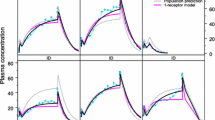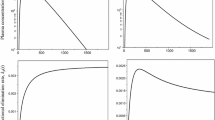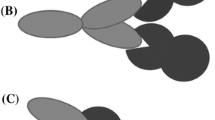Abstract
Introducing the phenomenoiogical concept of a time-varying fractional rate of elimination kD(t)and applying the theory of lifetime distributions, implications of the log-convexity of drug disposition curves are examined and some important applications are described. Linear pharmacokinetic systems exhibiting a log-convex impulse response and satisfying the basic conditions underlying the noncompartmental approach have the following properties: (1) The time-varying volume of distribution V(t)increases, and consequently the fractional rate of elimination kD(t)=CL/V(t)decreases monotonically. (2) The concentration-time curve and the time course of total amount of drug in the body, respectively, have an exponential tail [where V(t)approaches the equilibrium value VZ].The relative dispersion of residence times (CV 2D =VDRT/MDRT2)and the ratio Vss/VZ (V ss is the volume of distribution at steady state) act as measures of departure from pure monoexponential decay (one-compartment behaviour). The role of the latter parameters as shape parameters of the curve that characterize the distributional properties of drugs is discussed. Upper and lower bounds of the time course of drug amount in the body are derived using the parameters MDRTand CV 2D or λz (terminal exponential coefficient), respectively. This approach is also employed to construct upper bounds on the fractional error in AUCdetermination by numerical integration that is due to curve truncation. The significance of the fractional elimination rate concept as a unifying approach in interspecies pharmacokinetic scaling is pointed out. Some applications of the results are demonstrated, using digoxin data from the literature.
Similar content being viewed by others
References
J. J. DiStefano III. Noncompartmental vs. compartmental analysis: Some bases of choice.Am. J. Physiol. 243:R1-R6 (1982).
M. Weiss. Theorems on log-convex disposition curves in drug and tracer kinetics.J. Theor. Biol. 116:355–368 (1985).
R. E. Barlow and F. Proschan.Mathematical Theory of Reliability, Wiley, New York, 1965.
B. C. McInnis, S. A. El-Asfouri, and S. A. Kapadia. On stochastic compartmental modeling.Bull. Math. Biol. 41:611–613 (1979).
N. A. Lassen and W. Perl.Tracer Kinetic Methods in Medical Physiology, Raven, New York, 1979.
D. M. Himmelblau.Process Analysis by Statistical Methods, Wiley, New York, 1968.
M. Weiss, Definition of pharmacokinetic parameters: Influence of the sampling site.J. Pharmacokin. Biopharm. 12:167–176 (1984).
J. Keilson.Markov Chain Models—Rarity and Exponentiality, Springer, New York, 1979.
M. E. Wise. Negative power functions of time in pharmacokinetics and their implications.J. Pharmacokin. Biopharm. 13:309–346 (1985).
J. Eisenfeld. Relationship between stochastic and differential models of compartmental systems.Math. Biosci. 43:289–305 (1979).
J. H. Matis, T. E. Wehrly, and C. M. Metzler. On some stochastic formulations and related statistical moments of pharmacokinetic models.J. Pharmacokin. Biopharm. 11:77–92 (1983).
M. Weiss. A note on the role of generalized inverse Gaussian distributions of circulatory transit times in pharmacokinetics.J. Math. Biol. 18:95–102 (1984).
S. Niazi. Volume of distribution as a function of time.J. Pharm. Sci. 65:452–454 (1976).
M. Weiss. Hemodynamic influences upon the variance of disposition residence time distribution.J. Pharmacokin. Biopharm. 11:63–75 (1983).
K. Yamaoka, T. Tanigawara, T. Nakagawa, and T. Uno. Capacity-limited elimination of cefmetazole in rat.Int. J. Pharm. 10:291–300 (1982).
W. G. Kramer, A. J. Kolibash, R. P. Lewis, M. S. Bathala, J. A. Visconti, and R. H. Reunig. Pharmacokinetics of digoxin: Relationship between response intensity and predicted compartmental drug levels in man.J. Pharmacokin. Biopharm. 7:47–61 (1979).
M. Weiss. Model-independent assessment of accumulation kinetics based on moments of drug disposition curves.Eur. J. Clin. Pharmacol. 27:355–359 (1984).
P. Hall. On measures of the distance of a mixture from its parent distribution.Stoch. Process Appl. 8:357–365 (1979).
M. Weiss. Use of gamma distributed residence times in pharmacokinetics.Eur. J. Clin. Pharmacol. 25:695–705 (1983).
H. Boxenbaum. Interspecies scaling, allometry, physiological time, and the ground plan of pharmacokinetics.J. Pharmacokin. Biopharm. 10:201–227 (1982).
H. Boxenbaum and R. Ronfeld. Interspecies pharmacokinetic scaling and the Dedrick plots.Am. J. Physiol. 245:R768-R774 (1983).
R. L. Dedrick, K. B. Bischoff, and D. Z. Zaharko. Interspecies correlation of plasma concentration history of methotrexate.Cancer Chemother. Rep. I 54:95–101 (1970).
M. Weiss, W. Sziegoleit, and W. Förster. Dependence of pharmacokinetic parameters on the body weight.Int. J. Clin. Pharmacol. 15:572–575 (1977).
K. H. Norwich and S. Siu. Power functions in physiology and pharmacology.J. Theor. Biol 95:387–398 (1982).
G. T. Tucker, P. R. Jackson, G. C. A. Storey, and D. W. Holt. Amiodarone disposition: Polyexponential, power and gamma functions.Eur. J. Clin. Pharmacol. 26:655–656 (1984).
W. A. Colburn. A time-dependent volume of distribution term used to describe linear concentration-time profiles.J. Pharmacokin. Biopharm. 11:389–400 (1983).
K. Takada and S. Asada. A model independent approach to describe the blood disappearance profile of intravenously administered drugs.Chem. Pharm. Bull. 29:1462–1466 (1981).
M. Berman. Kinetic analysis of turnover date.Prog. Biochem. Pharmacol. 15:67–108 (1979).
J. G. Wagner. Significance of ratios of different volumes of distribution in pharmacokinetics.Biopharm. Drug. Dispos. 4:263–270 (1983).
M. Weiss. Importance of tissue distribution in determining drug disposition curves.J. Theor. Biol. 103:649–652 (1983).
J. Z. Hearon. The washout curve in tracer kinetics.Math. Biosci 3:31–39 (1968).
J. Z. Hearon. A monotonicity theorem for compartmental systems.Math. Biosci. 46:293–300 (1979).
J. H. Matis and T. E. Wehrly. Modelling pharmacokinetic variability on the molecular level with stochastic compartmental systems. In M. Rowland, L. B. Sheiner, and T. Steimer (eds.),Variability in Drug Therapy: Description, Estimation and Control, Raven Press, New York, 1985.
J. H. Matis and H. D. Tolley. On stochastic modelling of tracer kinetics.Fed. Proc. 39:104–109 (1980).
M. Weiss and W. Förster. Pharmacokinetic model based on circulatory transport.Eur. J. Clin. Pharmacol. 16:287–293 (1979).
D. G. Covell, M. Berman, and C. Delisi. Mean residence time—Theoretical development, experimental determination, and practical use in tracer analysis.Math. Biosci. 72:213–244 (1984).
M. Rowland and T. M. Tozer.Clinical Pharmacokinetics: Concepts and Applications, Lea and Febiger, Philadelphia, 1980.
M. Brown. Approximating IMRL distributions by exponential distributions with application to first passage times.Ann. Probability 11:419–427 (1983).
R. E. Barlow and F. Proschan.Statistical Theory of Reliability and Life Testing, Holt, Rinehart and Winston, New York, 1975.
Author information
Authors and Affiliations
Rights and permissions
About this article
Cite this article
Weiss, M. Generalizations in linear pharmacokinetics using properties of certain classes of residence time distributions. I. Log-convex drug disposition curves. Journal of Pharmacokinetics and Biopharmaceutics 14, 635–657 (1986). https://doi.org/10.1007/BF01067968
Received:
Revised:
Published:
Issue Date:
DOI: https://doi.org/10.1007/BF01067968




